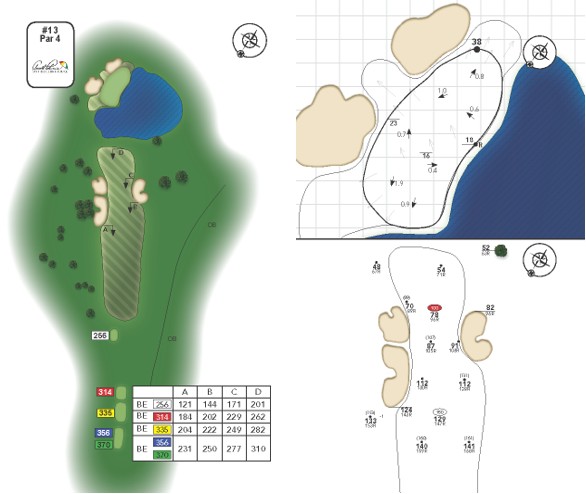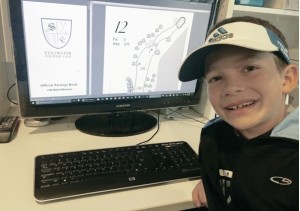By Seth Damsgard and Scott Brady
That laser rangefinder won’t tell you how to play each hole. Seth’s first junior events taught him (the hard way) that good club selection is not enough. Knowing the distance to the pin and how far each club goes does not always put you in the best scoring position. But with just a bit of course knowledge, there are strokes to be saved before your next starting time – especially when it’s not your home course.

During Scott’s 15 years of Tour caddying, course strategy was one of the most important aspects of tournament preparation. Where do we want to hit it, or rather where do we not want to hit it? He would walk each course backwards from #18 green to #1 tee looking at the best place to leave approach shots and the best way to play each hole. Where might it be okay to miss a green? Which club was best to hit off the tee? How might our game plan change from round to round? How would we play a hole if we needed to get aggressive?
Let’s say your next tournament will be held at Bay Hill, with the number-one handicap 13th hole requiring some significant decisions. Will you take out the big stick and hope you can make it past the fairway bunkers for an easy pitch over the water? Or do you go short, leaving yourself 150 yards to the well-guarded green? Perhaps the safest play would even be to bail out left for an up-and-down par, as long as the green slopes aren’t too wild. You don’t want to be making those decisions at the same time you’re feeling all the emotions of being tied for the lead with just a few holes to play. The good news is you don’t have to.
With a little bit of homework using the right tool, you can walk through many of those risk-reward options long before you set foot on the course, and maybe even get some good advice from your coach. For example, when should you think about laying up instead of going for it? Which doglegs might you be able to carry? Which side of the fairway should you play? What kind of hazards come into play? What will it take to carry that greenside bunker guarding a back left pin position? Where are your birdie opportunities and easy pin positions? And when might you think about bailing out to play it safe?
 If you aren’t already asking these questions before a round, you should be. Starting a round with real strategy based on actual course knowledge will give you the confidence to step up to each hole as if you’ve already played it multiple times. There are a number of tools you can use to walk through all the hazards, distances, and even slopes from the comfort of your own home.
If you aren’t already asking these questions before a round, you should be. Starting a round with real strategy based on actual course knowledge will give you the confidence to step up to each hole as if you’ve already played it multiple times. There are a number of tools you can use to walk through all the hazards, distances, and even slopes from the comfort of your own home.
GPS Apps
Pros: Gives a good overview of the hole; Can measure tee shots, gets nearly any course in the U.S., approach shots, and green depths/carries
Cons: Need to write down any personal notes; No uphill/downhill or green slopes; Often inaccurate or missing trees; has to be charged before using
Satellite Images
Pros: Available online; Gives a good overview of the hole with accurate trees; Google Earth allows for measuring any distance; easily accessible
Cons: Need to write down any personal notes; Images may be outdated and missing course renovations; Tee boxes, greens, and hazards may be blocked from view by tree cover; No uphill/downhill or green slopes
Yardage Books
Pros: Allowed for use in all tournaments; Usually surveyed by a professional caddie with tournament players in mind; Contains detailed measurements for tee shots, approach shots, and green complexes including slopes; Often includes uphill/downhill distance compensations which are only allowed in books; A place to keep your personal notes about each hole
Cons: Some courses do not yet have a tournament-quality book with this kind of information
Keep in mind that any notes you do use on the course while using a putter are affected by the 2019 USGA/R&A Rule Interpretation 4.3a/1 which limits paper size to 4 ¼” x 7” and green scale to ⅜” per 5 yards.
So, don’t let the local players have an advantage over you at the next tournament. Even if you get in a practice round, doing this kind of homework ahead of time will help you see more circles and fewer squares on that scorecard.
Seth Damsgard is 11 years old and plays on the Minnesota Junior PGA and U.S. Kids tours, and PGA Jr. League. At age 9, he started his own yardage book business, Golf by Numbers, and was listed as a Rising Star in the March 2017 issue of Junior Golf.
Scott Brady founded Precise Yardage Books in 2015 after caddying professionally for 15 years on the PGA, LPGA, and Web.com Tours. Scott and Seth have since partnered to create over 200 Precise books, which are used on the Web.com tour and at many PGA section, intercollegiate, and junior events across the United States.







